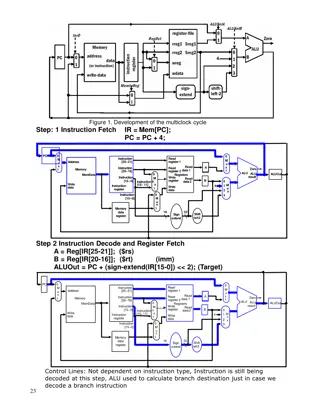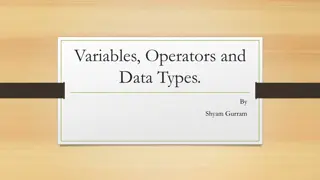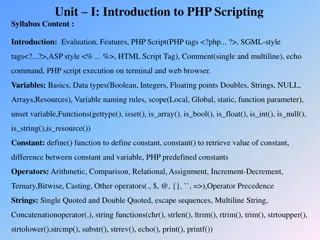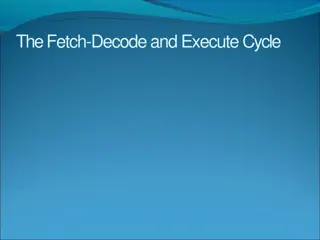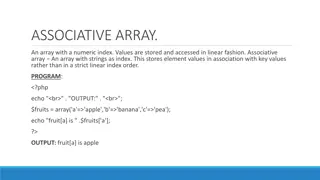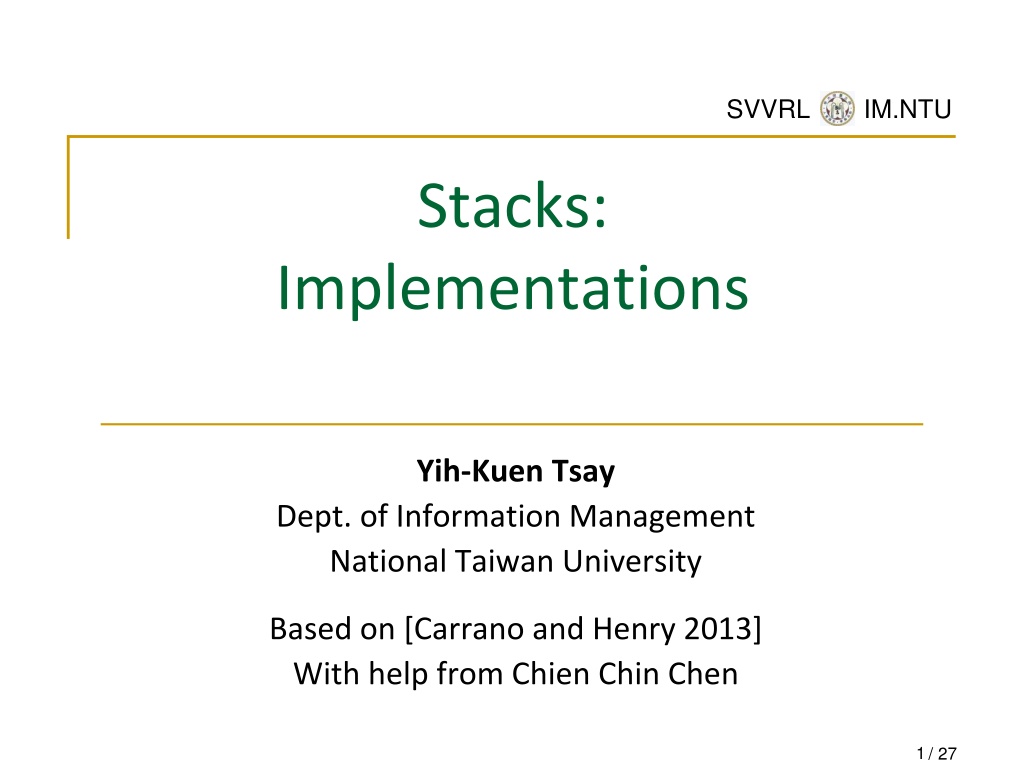
Implementing Stacks at National Taiwan University
"Explore implementations of ADT Stacks at National Taiwan University, based on Carrano and Henry's work. Learn about array-based and link-based implementations with the help of Yih-Kuen Tsay. Understand the basics and importance of hiding stack elements for data integrity. Get insights into array-based stack implementations and their key functions."
Download Presentation

Please find below an Image/Link to download the presentation.
The content on the website is provided AS IS for your information and personal use only. It may not be sold, licensed, or shared on other websites without obtaining consent from the author. If you encounter any issues during the download, it is possible that the publisher has removed the file from their server.
You are allowed to download the files provided on this website for personal or commercial use, subject to the condition that they are used lawfully. All files are the property of their respective owners.
The content on the website is provided AS IS for your information and personal use only. It may not be sold, licensed, or shared on other websites without obtaining consent from the author.
E N D
Presentation Transcript
SVVRL @ IM.NTU Stacks: Implementations Yih-Kuen Tsay Dept. of Information Management National Taiwan University Based on [Carrano and Henry 2013] With help from Chien Chin Chen 1 / 27
SVVRL @ IM.NTU Implementations of the ADT Stack As in the case of the ADT bag, we will consider both array-based and link-based implementations. The implementations will later be modified to use exceptions . Yih-Kuen Tsay DS 2016: Stacks: Implementations 2 / 27
SVVRL @ IM.NTU An Array-Based Implementation (1/9) The basic idea Source: FIGURE 7-1 in [Carrano and Henry 2013]. Yih-Kuen Tsay DS 2016: Stacks: Implementations 3 / 27
SVVRL @ IM.NTU An Array-Based Implementation (2/9) /** ADT stack: Array-based implementation. @file ArrayStack.h */ #ifndef _ARRAY_STACK #define _ARRAY_STACK #include "StackInterface.h" const int MAX_STACK = maximum-size-of-stack; template<class ItemType> class ArrayStack: public StackInterface<ItemType> { private: ItemType items[MAX_STACK]; // Array of stack items int top; // Index to top of stack Yih-Kuen Tsay DS 2016: Stacks: Implementations 4 / 27
SVVRL @ IM.NTU An Array-Based Implementation (3/9) What if you did not hide items and top, i.e., declare them as private? The client could access any element in the stack, not just the top element. This violates the specifications of the ADT stack. Yih-Kuen Tsay DS 2016: Stacks: Implementations 5 / 27
SVVRL @ IM.NTU An Array-Based Implementation (4/9) public: ArrayStack(); // Default constructor bool isEmpty() const; bool push(const ItemType& newEntry); bool pop(); ItemType peek() const; }; // end ArrayStack #include "ArrayStack.cpp" #endif Yih-Kuen Tsay DS 2016: Stacks: Implementations 6 / 27
SVVRL @ IM.NTU An Array-Based Implementation (5/9) /** @file ArrayStack.cpp */ #include <cassert> // For assert #include "ArrayStack.h" // Header file template<class ItemType> ArrayStack<ItemType>::ArrayStack(): top(-1) { } // end default constructor // Copy constructor and destructor are // supplied by the compiler Yih-Kuen Tsay DS 2016: Stacks: Implementations 7 / 27
SVVRL @ IM.NTU An Array-Based Implementation (6/9) template<class ItemType> bool ArrayStack<ItemType>::isEmpty() const { return top < 0; } // end isEmpty items MAX_STACK-1 top 1 -1 0 Yih-Kuen Tsay DS 2016: Stacks: Implementations 8 / 27
SVVRL @ IM.NTU An Array-Based Implementation (7/9) template<class ItemType> bool ArrayStack<ItemType>::push(const ItemType& newEntry) { bool result = false; if (top < MAX_STACK - 1) { // Stack has room for newEntry top++; items[top] = newEntry; result = true; } // end if items MAX_STACK-1 top return result; } // end push 1 -1 0 0 Yih-Kuen Tsay DS 2016: Stacks: Implementations 9 / 27
SVVRL @ IM.NTU An Array-Based Implementation (8/9) template<class ItemType> bool ArrayStack<ItemType>::pop() { bool result = false; if (!isEmpty ()) { top--; result = true; } // end if return result; } // end pop items MAX_STACK-1 top 1 -1 0 0 Yih-Kuen Tsay DS 2016: Stacks: Implementations 10 / 27
SVVRL @ IM.NTU An Array-Based Implementation (9/9) template<class ItemType> ItemType ArrayStack<ItemType>::peek() const { assert (!isEmpty()); // Enforce precondition // Stack is not empty; return top return items[top]; } // end peek // end of implementation file returned item items MAX_STACK-1 top 1 1 0 Yih-Kuen Tsay DS 2016: Stacks: Implementations 11 / 27
SVVRL @ IM.NTU Using the Stack Implementation #include <iostream> #include <string> #include "ArrayStack.h using namespace std; int main() { StackInterface<string>* stackPtr = new ArrayStack<string>(); string anItem = ; cout << Enter a string ; cin >> anItem; // Read an item stackPtr->push(anItem); // Push item onto stack } Yih-Kuen Tsay DS 2016: Stacks: Implementations 12 / 27
SVVRL @ IM.NTU A Link-Based Implementation (1/11) The basic idea: A pointer-based implementation enables the stack to grow and shrink dynamically. topPtr is a pointer to the head of a linked list of items. Because of the dynamically allocated memory, we must write a copy constructor and a destructor. Source: FIGURE 7-2 in [Carrano and Henry 2013]. Yih-Kuen Tsay DS 2016: Stacks: Implementations 13 / 27
SVVRL @ IM.NTU A Link-Based Implementation (2/11) /** ADT stack: Link-based implementation. @file LinkedStack.h */ #ifndef _LINKED_STACK #define _LINKED_STACK #include "StackInterface.h" #include "Node.h template<class ItemType> class LinkedStack: public StackInterface<ItemType> { private: Node<ItemType>* topPtr; // Pointer to first node in the chain; // this node contains the stack s top public: // Constructors and destructor: LinkedStack(); // Default constructor LinkedStack(const LinkedStack<ItemType>& aStack); // Copy constructor virtual ~LinkedStack(); // Destructor Yih-Kuen Tsay DS 2016: Stacks: Implementations 14 / 27
SVVRL @ IM.NTU A Link-Based Implementation (3/11) // Stack operations: bool isEmpty() const; bool push(const ItemType& newItem); bool pop(); ItemType peek() const; }; // end LinkedStack #include "LinkedStack.cpp" #endif Yih-Kuen Tsay DS 2016: Stacks: Implementations 15 / 27
SVVRL @ IM.NTU A Link-Based Implementation (4/11) /** @file LinkedStack.cpp */ #include <cassert> // For assert #include "LinkedStack.h" // Header file template<class ItemType> LinkedStack<ItemType>::LinkedStack(): topPtr(nullptr) { } // end default constructor topPtr points to nowhere when stack is empty. template<class ItemType> LinkedStack<ItemType>:: LinkedStack(const LinkedStack<ItemType>& aStack) { // Point to nodes in original chain Node<ItemType>* origChainPtr = aStack->topPtr; if (origChainPtr == nullptr) topPtr = nullptr; // Original stack is empty else { // Copy first node topPtr = new Node<ItemType>(); topPtr->setItem(origChainPtr->getItem()); // Point to first node in new chain Node<ItemType>* newChainPtr = topPtr; Yih-Kuen Tsay DS 2016: Stacks: Implementations 16 / 27
SVVRL @ IM.NTU A Link-Based Implementation (5/11) // Copy remaining nodes while (origChainPtr != nullptr) { // Advance original-chain pointer origChainPtr = origChainPtr->getNext(); // Get next item from original chain ItemType nextItem = origChainPtr->getItem(); // Create a new node containing the next item Node<ItemType>* newNodePtr = new Node<ItemType>(nextItem); // Link new node to end of new chain newChainPtr->setNext(newNodePtr); // Advance pointer to new last node newChainPtr = newChainPtr->getNext(); } // end while newChainPtr->setNext(nullptr); // Flag end of chain } // end if } // end copy constructor Yih-Kuen Tsay DS 2016: Stacks: Implementations 17 / 27
SVVRL @ IM.NTU A Link-Based Implementation (6/11) origChainPtr Copy first node aStack::topPtr topPtr Copy remaining nodes origChainPtr origChainPtr aStack::topPtr newChainPtr topPtr Yih-Kuen Tsay DS 2016: Stacks: Implementations 18 / 27
SVVRL @ IM.NTU A Link-Based Implementation (7/11) Flag end of new chain origChainPtr NULL aStack::topPtr newChainPtr topPtr Yih-Kuen Tsay DS 2016: Stacks: Implementations 19 / 27
SVVRL @ IM.NTU A Link-Based Implementation (8/11) template<class ItemType> LinkedStack<ItemType>::~LinkedStack() { // Pop until stack is empty while (!isEmpty ()) pop(); } // end destructor responsible for returning dynamically allocated memory to system. template<class ItemType> bool LinkedStack<ItemType>::isEmpty() const { return topPtr == nullptr; } // end isEmpty Yih-Kuen Tsay DS 2016: Stacks: Implementations 20 / 27
SVVRL @ IM.NTU A Link-Based Implementation (9/11) template<class ItemType> bool LinkedStack<ItemType>::push(const ItemType & newItem) { Node<ItemType>* newNodePtr = new Node<ItemType>(newItem, topPtr); topPtr = newNodePtr; newNodePtr = nullptr; return true; } // end push newNodePtr topPtr Yih-Kuen Tsay DS 2016: Stacks: Implementations 21 / 27
SVVRL @ IM.NTU A Link-Based Implementation (10/11) template<class ItemType> bool LinkedStack<ItemType>::pop() { bool result = false; if (!isEmpty()) { // Stack is not empty; delete top Node<ItemType>* nodeToDeletePtr = topPtr; topPtr = topPtr->getNext(); // Return deleted node to system nodeToDeletePtr->setNext(nullptr); delete nodeToDeletePtr; nodeToDeletePtr = nullptr; result = true; } // end if nodeToDeletePtr return result; } // end pop topPtr Yih-Kuen Tsay DS 2016: Stacks: Implementations 22 / 27
SVVRL @ IM.NTU A Link-Based Implementation (11/11) template<class ItemType> ItemType LinkedStack<ItemType>::peek() const { assert(!isEmpty()); // Enforce precondition // Stack is not empty; return top return topPtr->getItem(); } // end peek // end of implementation file Yih-Kuen Tsay DS 2016: Stacks: Implementations 23 / 27
SVVRL @ IM.NTU Using Exceptions (1/3) /** @file PrecondViolatedExcep.h */ #ifndef _PRECOND_VIOLATED_EXCEP #define _PRECOND_VIOLATED_EXCEP #include <stdexcept> #include <string> using namespace std; class PrecondViolatedExcep: public logic_error { public: PrecondViolatedExcep(const string& message = ""); }; // end PrecondViolatedExcep #endif Yih-Kuen Tsay DS 2016: Stacks: Implementations 24 / 27
SVVRL @ IM.NTU Using Exceptions (2/3) /** @file PrecondViolatedExcep.cpp */ #include "PrecondViolatedExcep.h" PrecondViolatedExcep::PrecondViolatedExcep(const string& message): logic_error("Precondition Violated Exception: " + message) { } // end constructor Yih-Kuen Tsay DS 2016: Stacks: Implementations 25 / 27
SVVRL @ IM.NTU Using Exceptions (3/3) Change to the declaration of peek: ItemType peek() const throw(PrecondViolatedExcep); Change to the implementation of peek: template<class ItemType> ItemType LinkedStack<ItemType>::peek() const throw(PrecondViolatedExcep) { // Enforce precondition if (isEmpty()) throw PrecondViolatedExcep( peek() called with empty stack ); // Stack is not empty; return top return topPtr->getItem(); } // end peek Yih-Kuen Tsay DS 2016: Stacks: Implementations 26 / 27
SVVRL @ IM.NTU Comparing Implementations Fixed versus dynamic sizes: A statically allocated array-based implementation. The size is known in advance, e.g., 80 characters in one line. Prevents the push operation from adding an item to the stack, if the array is full. A dynamically allocated pointer-based (or dynamically allocated array-based) implementation. No size restriction on the stack. Copy data between dynamically allocated data structures. Yih-Kuen Tsay DS 2016: Stacks: Implementations 27 / 27







